
A wedding is a ceremony in which two people are united in marriage. Wedding traditions and customs vary greatly between cultures, ethnicities, races, religions, denominations, countries, social classes, and sexual orientations. Most wedding ceremonies involve an exchange of marriage vows by a couple; a presentation of a gift ; and a public proclamation of marriage by an authority figure or celebrant. Special wedding garments are often worn, and the ceremony is sometimes followed by a wedding reception. Music, poetry, prayers, or readings from religious texts or literature are also commonly incorporated into the ceremony, as well as superstitious customs.

An engagement or betrothal is the period of time between the declaration of acceptance of a marriage proposal and the marriage itself. During this period, a couple is said to be fiancés, 'betrothed', 'intended', 'affianced', 'engaged to be married', or simply 'engaged'. Future brides and grooms may be called fiancée (feminine) or fiancé (masculine), 'the betrothed', a 'wife-to-be' or 'husband-to-be', respectively. The duration of the courtship varies vastly, and is largely dependent on cultural norms or upon the agreement of the parties involved.
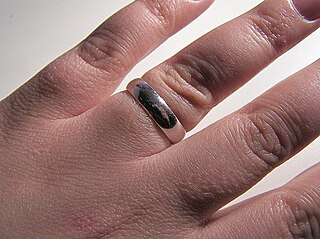
A wedding ring or wedding band is a finger ring that indicates that its wearer is married. It is usually forged from metal, traditionally gold or another precious metal. Rings were used in ancient Rome during marriage.
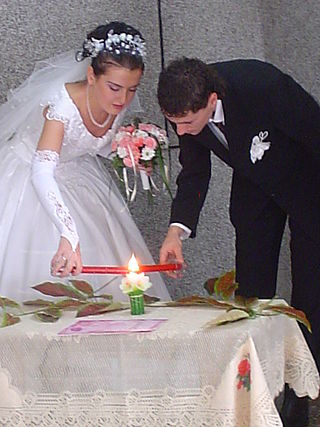
A unity candle is a candle used in a wedding ceremony to symbolize two people joining in marriage.
A Hindu wedding, also known as Vivaha, Marathi: Lagna (लग्न), Bhojpuri: Biyah (बियाह), Bengali: Bibaho (বিবাহ), Kalyanam, Kannada script: ಮದುವೆ (Maduve), Tamil: திருமணம் (Tirumanam), or Pelli, is the traditional wedding ceremony for Hindus. The wedding ceremonies are very colourful, and celebrations may extend for several days and usually a large number of people attend the wedding functions. The bride's and groom's home—entrance, doors, wall, floor, roof—are sometimes decorated with colors, flowers, and other decorations.
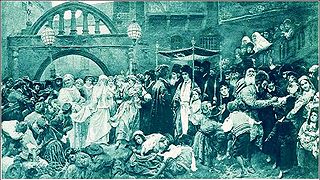
A Jewish wedding is a wedding ceremony that follows Jewish laws and traditions. While wedding ceremonies vary, common features of a Jewish wedding include a ketubah that is signed by two witnesses, a chuppah or huppah, a ring owned by the groom that is given to the bride under the canopy, and the breaking of a glass.

Weddings in India are festive occasions and usually celebrated with extensive decorations, color, music, dance, outfits and rituals that depend on the community, region and religion of the bride and the groom, as well as their preferences. India celebrates about 10 million weddings per year, of which about 80% are Hindu weddings. Approximately 90% of marriages in India are still arranged. Despite the rising popularity of love marriages, especially among younger generations, arranged marriages continue to be the predominant method for finding a marriage partner in India.
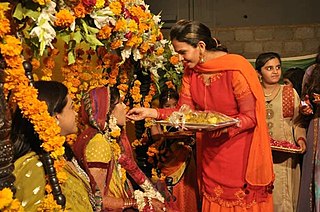
Marriage in Pakistan pertains to wedding traditions established and adhered by Pakistani men and women. Despite their local and regional variations, marriages in Pakistan generally follow Islamic marital jurisprudence. Marriages are not only seen as a union between a husband and a wife, but also an alliance between their respective families. These traditions extend to other countries around in the world where Overseas Pakistani communities exist.
A Brunei Malay wedding has many types of ceremonies.

Russian weddings held great importance in their culture and tradition, evolving differently according the region, but maintaining common points. They can last between two days and one week usually involving activities like dancing, singing, toasting, and banqueting. The best man and bridesmaid are called "Witnesses" or "Свидетели" in Russian. The ceremony and the ring exchange take place on the first day of the wedding. Russian weddings ceremonies have undertaken a certain amount of Western traditions, including incorporating maids of honour into the wedding party.
Ukrainian wedding is the traditional marriage ceremony in Ukrainian culture, both in Ukraine and in the Ukrainian diaspora. The traditional Ukrainian wedding featured a rich assortment of folk music and singing, dancing, and visual art, with rituals dating back to the pre-Christian era. Over time, the ancient pagan traditions and symbols were integrated into Christian ones.

Traditional marriage customs in the Philippines and Filipino wedding practices pertain to the characteristics of marriage and wedding traditions established and adhered by them Filipino men and women in the Philippines after a period of adoption courtship and engagement. These traditions extend to other countries around the world where Filipino communities exist. Kasalan is the Filipino word for "wedding", while its root word – kasal – means "marriage". The present-day character of marriages and weddings in the Philippines were primarily influenced by the permutation of Christian, both Catholic and Protestant, Hindu, Islam, Chinese, Spanish, and American models.
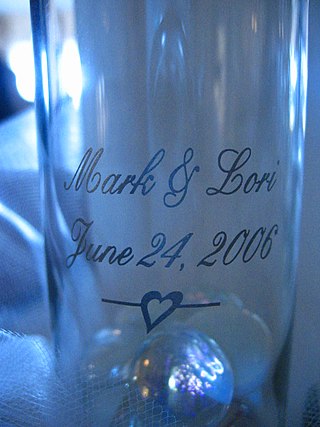
Las arras, or las arras matrimoniales are wedding paraphernalia used in Christian wedding ceremonies in Spain, Latin American countries, and the Philippines. The tradition is also followed, with varying names and customs, in other countries and communities bearing degrees of Hispanic influence. Traditionally, in Spain and Latin America, it is made up of thirteen gold coins presented in an ornate box or chest; in the Philippines, it is in an ornate basket or pouch. After being blessed by a priest, they are given or presented by the groom to the bride.
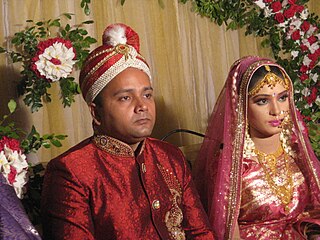
Muslim marriage and Islamic wedding customs are traditions and practices that relate to wedding ceremonies and marriage rituals prevailing within the Muslim world. Although Islamic marriage customs and relations vary depending on country of origin and government regulations, both Muslim men and women from around the world are guided by Islamic laws and practices specified in the Quran. Islamic marital jurisprudence allows Muslim men to be married to multiple women.
A flower girl is a young female who scatters flower petals down the aisle during a wedding procession.
The Telugu Hindu wedding ceremony is the traditional wedding ceremony of the Telugu people in India. In the 19th century, the ceremony could last up to sixteen days. In modern times, it can last two or more days, depending on the family's financial and social status. The pelli or wedding is considered the strongest of social bonds, and is said to spiritually merge two souls opening the doors to gruhastaashramam. There is a Telugu saying that "Marriage is supposed to be a family union and not an individual formality." However, with changing mindset of the younger generation and due to globalization, marriage these days is being mainly focused solely on the union of the young couple only.
Bahaghara is the Hindu wedding ceremony performed by Odia people in the Indian state of Odisha. It is the main ritual of an Odia Hindu wedding.

Traditional Hajong marriage is a ceremonial ritual that involves a marriage established by pre-arrangement between families. Within Hajong culture, romantic love and widow re-marriage were allowed, and monogamy was the norm for the Hajong people.

The nuptial veil, which is also referred to as the care cloth, carde clothe or wedding canopy, is an ancient Christian wedding tradition where a cloth is held over the heads of the bride and groom during the Nuptial Blessing. Symbolizing the "marriage yoke joining the bride and groom together", it is a rectangular linen or silk sheet smaller than the analogous Chuppah of Judaism, typically featuring a red pattern or a red cord, and is white in color. St. Isidore of Seville explained that the white represents the purity of Christian and marital love, while the red signifies the continuation of the family bloodline.














